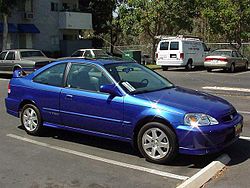
This is very nice Civic, but the gear at dashboard make this civic funy. In 2002, the Civic Si received a complete redesign and returned to form as a hatchback. The body shape of this model was based on the "New Bullet-Form" concept, which aimed to create a more dynamic look and provide greater stability while traveling on highways or winding country roads.
The interior layout also distinguished itself from other Civic Si generations with a dash-mounted shifter. Based on a platform manufactured at the Swindon plant in England, the hatchback was launched around the world in many different trims, most notably as the Civic Type R in Europe and Japan. Shifting away from the B-series engine, the seventh generation Civic Si adopted the K-series K20A3 engine, which put down 160 hp (119 kW) at 6,500 RPM and 132 lb·ft (179 N·m) of torque at 5,000 rpm.[12] With a redline of 6,800 RPM, the Si distanced itself from the narrow, high-RPM powerband engine of its predecessor, and as a result saw a 20 percent increase in torque.
Performance was relatively underwhelming compared to the competition; the switch to MacPherson struts from double-wishbone suspension resulted in less responsive handling, and a near-150 lb increase in weight to 2,744 lb contributed to slower acceleration than the lighter '99-'00 Si. Much of the weight gain is attributed to the chassis' stouter structure when compared to the previous generation hatchback, with the '02 Si boasting an increase in torsional rigidity by 95 percent and a bending rigidity increase of 22 percent. With the increased chassis rigidity compensating for weight gain, the 5th-generation Civic Si saw roughly the same performance numbers as the previous generation Si, with 7.6 seconds to 60 mph and 15.8 seconds at the quarter mile.
Other factors adversely impacting performance included the lack of an LSD (limited slip differential) and having to shift into third gear to get to 60. First gear ends at about 30, second ends at 55, and third ends at 82 mph (132 km/h). The '04-'05 models received minor revisions. Cosmetic changes included revised headlight (dual bulb setup) and taillight designs, standard side skirts, and an option for a HFP.
The suspension was updated with a change from 4 lug to 5 lug bolt pattern, a larger rear sway bar, and a change from the 15-inch wheels (195/60-15) to the 16-inch wheels (205/55-16).
The interior received more silver accents in place of the chrome ones (the lock switch).
The Honda chassis code for the Si and Type-R models is EP3. In Canada it is referred to as the Honda Civic SiR, and was discontinued in 2005. There was no high performance Si derived from the seventh generation USDM Civic sedan or coupe.
from wikipedia.org
I like this stuff and maybe you could too...




